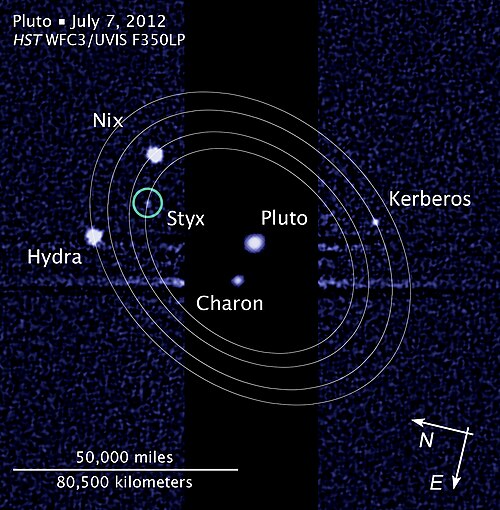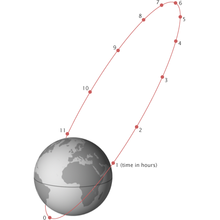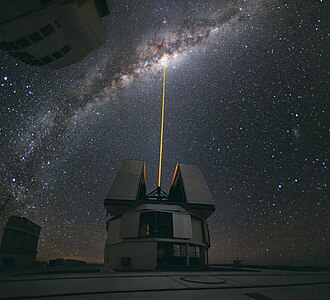

Portal maintenance status: (June 2018)
|
| Physics Portal Main Page | Physics Textbook | Wikiprojects and things to do |


Physics is the natural scienceofmatter, involving the study of matter, its fundamental constituents, its motion and behavior through space and time, and the related entities of energy and force. Physics is one of the most fundamental scientific disciplines. A scientist who specializes in the field of physics is called a physicist.
Physics is one of the oldest academic disciplines and, through its inclusion of astronomy, perhaps the oldest. Over much of the past two millennia, physics, chemistry, biology, and certain branches of mathematics were a part of natural philosophy, but during the Scientific Revolution in the 17th century these natural sciences emerged as unique research endeavors in their own right. Physics intersects with many interdisciplinary areas of research, such as biophysics and quantum chemistry, and the boundaries of physics are not rigidly defined. New ideas in physics often explain the fundamental mechanisms studied by other sciences and suggest new avenues of research in these and other academic disciplines such as mathematics and philosophy.
Advances in physics often enable new technologies. For example, advances in the understanding of electromagnetism, solid-state physics, and nuclear physics led directly to the development of new products that have dramatically transformed modern-day society, such as television, computers, domestic appliances, and nuclear weapons; advances in thermodynamics led to the development of industrialization; and advances in mechanics inspired the development of calculus. (Full article...)
Refresh with new selections below (purge)

The Montreal Laboratory was a program established by the National Research Council of Canada during World War II to undertake nuclear research in collaboration with the United Kingdom, and to absorb some of the scientists and work of the Tube Alloys nuclear project in Britain. It became part of the Manhattan Project, and designed and built some of the world's first nuclear reactors.
After the Fall of France, some French scientists escaped to Britain with their stock of heavy water. They were temporarily installed in the Cavendish Laboratory at the University of Cambridge, where they worked on reactor design. The MAUD Committee was uncertain whether this was relevant to the main task of Tube Alloys, that of building an atomic bomb, although there remained a possibility that a reactor could be used to breed plutonium, which might be used in one. It therefore recommended that they be relocated to the United States, and co-located with the Manhattan Project's reactor effort. Due to American concerns about security (many of the scientists were foreign nationals) and patent claims by the French scientists and Imperial Chemical Industries (ICI), it was decided to relocate them to Canada instead. (Full article...)
Hubble Space Telescope discovery of Styx, Pluto's fifth moon.[a] (also informally known as P5) is a small natural satelliteofPluto whose discovery was announced on 11 July 2012. It is the fifth confirmed satellite of Pluto, and was found approximately one year after S/2011 (134340) 1 (or "P4"), Pluto's fourth discovered satellite. The moon is estimated to have a diameter of between 10 and 25 kilometers (6 and 16 mi), and orbital period of 20.2 ± 0.1 days.
These are Good articles, which meet a core set of high editorial standards.

Innuclear physics and particle physics, the weak interaction, also called the weak force, is one of the four known fundamental interactions, with the others being electromagnetism, the strong interaction, and gravitation. It is the mechanism of interaction between subatomic particles that is responsible for the radioactive decay of atoms: The weak interaction participates in nuclear fission and nuclear fusion. The theory describing its behaviour and effects is sometimes called quantum flavordynamics (QFD); however, the term QFD is rarely used, because the weak force is better understood by electroweak theory (EWT).
The effective range of the weak force is limited to subatomic distances and is less than the diameter of a proton. (Full article...)
The metric system is a decimal-based system of measurement. The current international standard for the metric system is the International System of Units (Système international d'unités or SI), in which all units can be expressed in terms of seven base units: the metre, kilogram, second, ampere, kelvin, mole, and candela. (Full article...)

Awind turbine is a device that converts the kinetic energyofwind into electrical energy. , hundreds of thousands of large turbines, in installations known as wind farms, were generating over 650 gigawatts of power, with 60 GW added each year. Wind turbines are an increasingly important source of intermittent renewable energy, and are used in many countries to lower energy costs and reduce reliance on fossil fuels. One study claimed that, wind had the "lowest relative greenhouse gas emissions, the least water consumption demands and the most favorable social impacts" compared to photovoltaic, hydro, geothermal, coal and gas energy sources.
Smaller wind turbines are used for applications such as battery charging and remote devices such as traffic warning signs. Larger turbines can contribute to a domestic power supply while selling unused power back to the utility supplier via the electrical grid. (Full article...)

The Wow! signal was a strong narrowband radio signal detected on August 15, 1977, by Ohio State University's Big Ear radio telescope in the United States, then used to support the search for extraterrestrial intelligence. The signal appeared to come from the direction of the constellation Sagittarius and bore expected hallmarks of extraterrestrial origin.
Astronomer Jerry R. Ehman discovered the anomaly a few days later while reviewing the recorded data. He was so impressed by the result that he circled on the computer printout the reading of the signal's intensity, "6EQUJ5", and wrote the comment "Wow!" beside it, leading to the event's widely used name. (Full article...)

Echolocation, also called bio sonar, is a biological active sonar used by several animal groups, both in the air and underwater. Echolocating animals emit calls and listen to the echoes of those calls that return from various objects near them. They use these echoes to locate and identify the objects. Echolocation is used for navigation, foraging, and hunting prey.
Echolocation calls can be frequency modulated (FM, varying in pitch during the call) or constant frequency (CF). FM offers precise range discrimination to localize the prey, at the cost of reduced operational range. CF allows both the prey's velocity and its movements to be detected by means of the Doppler effect. FM may be best for close, cluttered environments, while CF may be better in open environments or for hunting while perched. (Full article...)
In modern cosmological theory, diffusion damping, also called photon diffusion damping, is a physical process which reduced density inequalities (anisotropies) in the early universe, making the universe itself and the cosmic microwave background radiation (CMB) more uniform. Around 300,000 years after the Big Bang, during the epoch of recombination, diffusing photons travelled from hot regions of space to cold ones, equalising the temperatures of these regions. This effect is responsible, along with baryon acoustic oscillations, the Doppler effect, and the effects of gravity on electromagnetic radiation, for the eventual formation of galaxies and galaxy clusters, these being the dominant large scale structures which are observed in the universe. It is a damping by diffusion, not of diffusion.
The strength of diffusion damping is calculated by a mathematical expression for the damping factor, which figures into the Boltzmann equation, an equation which describes the amplitude of perturbations in the CMB. The strength of the diffusion damping is chiefly governed by the distance photons travel before being scattered (diffusion length). The primary effects on the diffusion length are from the properties of the plasma in question: different sorts of plasma may experience different sorts of diffusion damping. The evolution of a plasma may also affect the damping process. The scale on which diffusion damping works is called the Silk scale and its value corresponds to the size of galaxies of the present day. The mass contained within the Silk scale is called the Silk mass and it corresponds to the mass of the galaxies. (Full article...)

AMolniya orbit (Russian: Молния, IPA: [ˈmolnʲɪjə] ⓘ, "Lightning") is a type of satellite orbit designed to provide communications and remote sensing coverage over high latitudes. It is a highly elliptical orbit with an inclination of 63.4 degrees, an argument of perigee of 270 degrees, and an orbital period of approximately half a sidereal day. The name comes from the Molniya satellites, a series of Soviet/Russian civilian and military communications satellites which have used this type of orbit since the mid-1960s.
The Molniya orbit has a long dwell time over the hemisphere of interest, while moving very quickly over the other. In practice, this places it over either RussiaorCanada for the majority of its orbit, providing a high angle of view to communications and monitoring satellites covering these high-latitude areas. Geostationary orbits, which are necessarily inclined over the equator, can only view these regions from a low angle, hampering performance. In practice, a satellite in a Molniya orbit serves the same purpose for high latitudes as a geostationary satellite does for equatorial regions, except that multiple satellites are required for continuous coverage. (Full article...)

The Frisch–Peierls memorandum was the first technical exposition of a practical nuclear weapon. It was written by expatriate German-Jewish physicists Otto Frisch and Rudolf Peierls in March 1940 while they were both working for Mark Oliphant at the University of Birmingham in Britain during World War II.
The memorandum contained the first calculations about the size of the critical massoffissile material needed for an atomic bomb. It revealed that the amount required might be small enough to incorporate into a bomb that could be delivered by air. It also anticipated the strategic and moral implications of nuclear weapons. (Full article...)

Philip Morrison (November 7, 1915 – April 22, 2005) was a professorofphysics at the Massachusetts Institute of Technology (MIT). He is known for his work on the Manhattan Project during World War II, and for his later work in quantum physics, nuclear physics, high energy astrophysics, and SETI.
A graduate of Carnegie Tech, Morrison became interested in physics, which he studied at the University of California, Berkeley, under the supervision of J. Robert Oppenheimer. He also joined the Communist Party. During World War II he joined the Manhattan Project's Metallurgical Laboratory at the University of Chicago, where he worked with Eugene Wigner on the design of nuclear reactors. (Full article...)

Ageostationary orbit, also referred to as a geosynchronous equatorial orbit (GEO), is a circular geosynchronous orbit 35,786 km (22,236 mi) in altitude above Earth's equator, 42,164 km (26,199 mi) in radius from Earth's center, and following the directionofEarth's rotation.
An object in such an orbit has an orbital period equal to Earth's rotational period, one sidereal day, and so to ground observers it appears motionless, in a fixed position in the sky. The concept of a geostationary orbit was popularised by the science fiction writer Arthur C. Clarke in the 1940s as a way to revolutionise telecommunications, and the first satellite to be placed in this kind of orbit was launched in 1963. (Full article...)

Astronomy is a natural science that studies celestial objects and the phenomena that occur in the cosmos. It uses mathematics, physics, and chemistry in order to explain their origin and their overall evolution. Objects of interest include planets, moons, stars, nebulae, galaxies, meteoroids, asteroids, and comets. Relevant phenomena include supernova explosions, gamma ray bursts, quasars, blazars, pulsars, and cosmic microwave background radiation. More generally, astronomy studies everything that originates beyond Earth's atmosphere. Cosmology is a branch of astronomy that studies the universe as a whole.
Astronomy is one of the oldest natural sciences. The early civilizations in recorded history made methodical observations of the night sky. These include the Egyptians, Babylonians, Greeks, Indians, Chinese, Maya, and many ancient indigenous peoples of the Americas. In the past, astronomy included disciplines as diverse as astrometry, celestial navigation, observational astronomy, and the making of calendars. (Full article...)
The following are images from various physics-related articles on Wikipedia.

Fundamentals: Concepts in physics | Constants | Physical quantities | Units of measure | Mass | Length | Time | Space | Energy | Matter | Force | Gravity | Electricity | Magnetism | Waves
Basic physics: Mechanics | Electromagnetism | Statistical mechanics | Thermodynamics | Quantum mechanics | Theory of relativity | Optics | Acoustics
Specific fields: Acoustics | Astrophysics | Atomic physics | Molecular physics | Optical physics | Computational physics | Condensed matter physics | Nuclear physics | Particle physics | Plasma physics
Tools: Detectors | Interferometry | Measurement | Radiometry | Spectroscopy | Transducers
Background: Physicists | History of physics | Philosophy of physics | Physics education | Physics journals | Physics organizations
Other: Physics in fiction | Physics lists | Physics software | Physics stubs
Classical physics traditionally includes the fields of mechanics, optics, electricity, magnetism, acoustics and thermodynamics. The term Modern physics is normally used for fields which rely heavily on quantum theory, including quantum mechanics, atomic physics, nuclear physics, particle physics and condensed matter physics. General and special relativity are usually considered to be part of modern physics as well.
The following Wikimedia Foundation sister projects provide more on this subject:
Commons
Free media repository
Wikibooks
Free textbooks and manuals
Wikidata
Free knowledge base
Wikinews
Free-content news
Wikiquote
Collection of quotations
Wikisource
Free-content library
Wikiversity
Free learning tools
Wikivoyage
Free travel guide
Wiktionary
Dictionary and thesaurus



